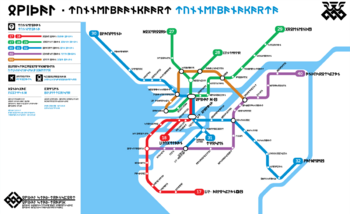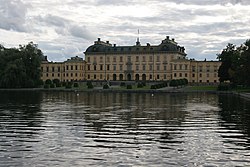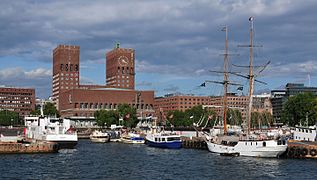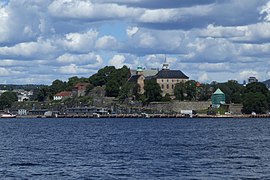Ovedal: Difference between revisions
Pokemarick (talk | contribs) |
Pokemarick (talk | contribs) No edit summary |
||
| Line 49: | Line 49: | ||
| website = <!-- {{URL|http://www.owidal.hl/}} --> | | website = <!-- {{URL|http://www.owidal.hl/}} --> | ||
}} | }} | ||
'''Owidal''', is the capital of [[Hellona]] and the most populous city in Hellona, with 972,119 people living in the municipality Owidal City, approximately 1.7 million in the urban area, and 2.3 million in the metropolitan area, the Owidal Capital Community. The city is located in | '''Owidal''', is the capital of [[Hellona]] and the most populous city in Hellona, with 972,119 people living in the municipality Owidal City, approximately 1.7 million in the urban area, and 2.3 million in the metropolitan area, the Owidal Capital Community. The city is located in northwest Hellona and is located at the mouth of the river Andus. The area has been settled since the Stone Age, in the 6th millennium BC, and was founded as a city in 1198. It also acts as the capital of the province of [[Andus]]. | ||
Owidal is the cultural, media, political, and economic centre of Hellona. It is an important global city | Owidal is the cultural, media, political, and economic centre of Hellona. It is an important global city and one of the main centres of diplomacy between the countries of the Vismar Commonwealth. Hellona's national football arena is located north of the city centre, which also acts as the main arena for the biggest football club of Hellona, FC Valv Kristof. | ||
Owidal is the seat of the Hellonian government, its agencies and the Hellonian monarch. Both chambers of the | Owidal is the seat of the Hellonian government, its agencies and the Hellonian monarch. Both chambers of the Ryksdag are seated in the Rykshof, with the residence of the Great-Minister situated in a manor house opposite of the Rykshof. The Owidal Palace is the official residence and workplace of the Hellonian monarch. | ||
==History== | ==History== | ||
Owidal's historic core, the old town, has been inhabited after the end of the Ice Age. The city sprung up on | Owidal's historic core, the old town, has been inhabited after the end of the Ice Age. The city sprung up on a peninsula, which now lies in the middle of the modern-day city, in the 1st century BC. This area, which still forms the historic core of the greater metropolitan area, was the area the city was mostly limited to for most of its early existence. Owidal became the seat of the kingdom of Andus, one of the many petty kingdoms that arose in the 1st to 2nd century. Due to its position as capital of Andus, it grew in prominence and became a major hub for trade in modern-day Western Hellona. Owidal grew in prominence as an important economic, cultural and political hub when the Wars of Unification in the 4th to 11th century resulted in the growing importance of the Andus area due to its conquest of Hellona. When Hellona was formed in 1012 it was declared capital of the new country. Because of the promotion of colonialism, expansion and trade by King Björn-Wodanerson and his descendants, the city became an important link in the newly established trade routes. It became the centre of trade in the Vismar region, developing strong economic and cultural linkages with Munich, Novak and other cities throughout the region. | ||
===12th and 13th century=== | ===12th and 13th century=== | ||
Revision as of 15:43, 1 May 2020
Owidal
ᛟᚹᛁᚦᚨᛚ | |
|---|---|
| Owidal City ᛟᚹᛁᚦᚨᛚ ᛋᛏᚨᚦ | |
|
From top down, left to right: Overview of Owidal, office buildings in Achterbou-Tirsen, modern skyscrapers in Uitlenderbou, the Hellonian National Concert Hall, the Vismar Museum and the Royal Palace | |
| Nickname: Queen of the Vismar | |
| Motto(s): | |
 Location of Owidal within the Owidal Capital Community | |
| Country | |
| Province | |
| Established | 120 BC |
| Government | |
| • Mayor | Emma Janssen (Social Democrats) |
| Population (1990) | |
| • Total | 1,185,934 |
| • Rank | 2,549,648 |
| Demonym | Owidaler |
Owidal, is the capital of Hellona and the most populous city in Hellona, with 972,119 people living in the municipality Owidal City, approximately 1.7 million in the urban area, and 2.3 million in the metropolitan area, the Owidal Capital Community. The city is located in northwest Hellona and is located at the mouth of the river Andus. The area has been settled since the Stone Age, in the 6th millennium BC, and was founded as a city in 1198. It also acts as the capital of the province of Andus.
Owidal is the cultural, media, political, and economic centre of Hellona. It is an important global city and one of the main centres of diplomacy between the countries of the Vismar Commonwealth. Hellona's national football arena is located north of the city centre, which also acts as the main arena for the biggest football club of Hellona, FC Valv Kristof.
Owidal is the seat of the Hellonian government, its agencies and the Hellonian monarch. Both chambers of the Ryksdag are seated in the Rykshof, with the residence of the Great-Minister situated in a manor house opposite of the Rykshof. The Owidal Palace is the official residence and workplace of the Hellonian monarch.
History
Owidal's historic core, the old town, has been inhabited after the end of the Ice Age. The city sprung up on a peninsula, which now lies in the middle of the modern-day city, in the 1st century BC. This area, which still forms the historic core of the greater metropolitan area, was the area the city was mostly limited to for most of its early existence. Owidal became the seat of the kingdom of Andus, one of the many petty kingdoms that arose in the 1st to 2nd century. Due to its position as capital of Andus, it grew in prominence and became a major hub for trade in modern-day Western Hellona. Owidal grew in prominence as an important economic, cultural and political hub when the Wars of Unification in the 4th to 11th century resulted in the growing importance of the Andus area due to its conquest of Hellona. When Hellona was formed in 1012 it was declared capital of the new country. Because of the promotion of colonialism, expansion and trade by King Björn-Wodanerson and his descendants, the city became an important link in the newly established trade routes. It became the centre of trade in the Vismar region, developing strong economic and cultural linkages with Munich, Novak and other cities throughout the region.
12th and 13th century
In the 12th and 13th century, Owidal grew to become one of the wealthiest cities in the region. Ships from Owidal sailed towards Norsund, the Menako Islands and Latvian Spartopia forming a worldwide trading network.
After the Eastern Revolt, a small stagnation in the economic growth of Owidal happened. This was largely the result of legislation leading to forced relocations of companies and resources to the poorer east. However, it kept its important role as the trading hub of the Vismar, with most of the goods going from and to Hellona passing through Owidal.
After the establishment of the unitary state in 1401, the importance of Owidal as a centre for the government grew. Owidal expanded to house new civil servants, ministries and other governmental organisations. The years after Owidal continued to grow. During the Germano-Hellonian Wars, Owidal largely managed to maintain dominance in the region due to the Vismar Sea being under control by the Hellonian Royal Navy.
Hellonian Peace and industralisation
The city long maintained a stable population since the 1600's, with stagnating growth. During the Hellonian peace, trade activity in Hellona grew and the port of Hellona was expanded. Later in the 18th century the city industrialised. During this process new industries emerged and Owidal was transformed into an important trade and service centre as well as a key gateway point within Hellona. The population grew dramatically, with increasing immigration. New institutes, academies and universities sprang up.
Modern era
With the establishment of the Vismar Union in 1886, Owidal became one of the fastest growing cities in the region. It became a modern, technologically advanced and ethnically diverse city.
Geography
Owidal is located on a low-lying part of the rocky north-western coast of Hellona, where the Andus river flows out into the Vismar Sea. The central part of the city is located on ten islands located in the delta of the Andus. Crisscrossed canals further divide areas on the mainland.
Owidal falls under the authority of the Owidal Municipality, which calls itself Owidal City, controls the areas of the Old Town, Noorderoord and Zuideroord. The metropolitan area of Owidal largely falls outside this region. These largely urban areas are under control of other municipalities, but all have set up the Owidal Metropolitan Area for control of city growth.
The city of Owidal is further divided into districts, which carry responsibilities for social, leisure and cultural entities and services in their respective regions. The municipality is often divided into three main parts, the City Centre (Innerstad/Innerstaden), Noorderoord and Zuideroord
Owidal City Centre
- Old Town
- Wodanerholm
- Westerholm
- Royal Game Park
- Den Poort
- Valv Germana
Noorderoord
- Asterveld-Noorderhaven
- Hunsoord
- Ellanderholmen (Ellandic quarter)
- Steneren
Noorderoord
- Stadrand
- Achterbou-Tyrsen
- Strandmalm
- Uitlenderbou
Transport
Owidal has an extensive public transport system. It consists of the Owidal metro (Hellonian: ᛏᚢᚾᚾᛖᛚᛒᚨᚨᚾ tunnelbaan; Ellandic: ᛏᚢᚾᚾᛖᛚᛒᚨᚾᚨ Tunnelbana), which itself consists of five main colour-coded lines, all connected to the inner-city with the blue lines 30, 31, 32; the green lines 27, 28, 29, red line 17 and the purple line 40 leading to the outer parts of Owidal and the Capital Region. The inner-city is furthermore connected with tram and ferry lines and bus transportation. Owidal has three train stations in its whole metropolitan area: Owidal Central, Vl. Kristof and Groeneind, which connects Owidal with other big cities in Andus and the rest of the country.
The metropolitan system of Owidal is organised under Owidaler Tunnelbaan (OT), which is owned by all municipalities it runs through. All other modes of public transport, like the tram, ferry and bus lines, are wholly owned by the Owidal Municipal Council.
All public transportation is publicly owned in Hellona, with trains being controlled by the national government and local transport being in the hands of the municipality; or in Owidal's case several municipalities. Therefore people can use one public transport card, which bases its price on distance travelled, troughout the whole country for every means of transportation. For foreigners and tourists, who can't register themselves for these, individual travel tickets are bought for trains and weekly transport cards for metro, tram and bus travel.
Airport
For both domestic and international flights Owidal is connected to:
- Owidal-Vl. Kristof International Airport (VKN) is the largest and busiest airport of Hellona. It is located 8km from Owidal.
- Andersson Airport (AAN) is located 40km from Owidal.
Owidal-Vl. Kristof International Airport is connected to Owidal by commuter, regional and intercity rail and by the metro line 17, which is with a travel time of 20 minutes the fastest way of getting to the Owidal centre from the aiport.
Demographics
As the capital of Hellona and the Kingdom of Andus, Owidal was historically inhabitated by mostly Andusian Hellonics. When Andus unified with Elland to form Hellona, a big influx of Ellandics came to Owidal.
Nowadays, Owidal houses many more ethnicities as an important city in the Vismar Commonwealth. About 76% of the population identifies as ethnic Vismaric; which includes Hellonians, Ellandics, South Germans, Nambalonians, Menakupans and Dutch Polynese. 24% is ethnically not Vismaric, the biggest groups being Arialucians, Libertanians, and Latvian Spartopians. There are small immigrant groups of Lilotukans and Norsundish natives, which are mostly spread over the rest of the country, in contrast to others which mostly are concentrated in the capital or other big cities.
Owidal has several religious communities. In 1930, these were mostly split between ethnicities. Most Hellonian and Ellandic citizens followed Asatru, with in total 60% of Owidaler inhabitants following Asatru. Irreligious people formed the second largest group with around 35% adhering to no religion. 5% followed various other religions.
Economy
Owidal's economy was largely based on trade for most of its history, and is still the financial capital of Hellona. Owidal houses many headquarters of many big corporations, like the Hellonian Royal Trading Company, the HKB Group, Uylen and Greatbuy.tri. These large corporations are mostly found in the outer ring of the city, while many more traditional and small businesses in the inner city and especially the Old Town.
Port of Owidal
Due to Owidal's advantageous position being located at the mouth of the Vismar Sea, trade and shipping have always played an important part in Owidaler history. The port of Owidal has grown to be the largest in the Vismar region. It is the 8th largest container port on Ullar.
The port's main activities are general cargo handling, transshipment and bulk cargo. The harbour functions as an important transit point for bulk materials between the Vismar region and overseas. From Owidal goods are transported by ship, river barge, train or road. The Trailing Line connects Owidal with the Hellonian hinterland and important northern cities in the South German States.
Tourism
Owidal has been increasing in popularity as a tourist destination all over Ullar. This is mostly because increasing visits from the more local Vismar region.
Retail
Retail in Owidal ranges from big known brands from all over Ullar to small privately owned stores. The most popular shopping district is in Wodanerholm, which includes the busiest street, Koningspromenade, high-end retail in the Vl. Kuylenstraat and the Ylingerdijk and small private stores with a variety of products; like traditional candy and other food related stores, clothing, sneakers, wedding clothing, interior shops, books, fine-dining, cafés, racing and mountain bikes and skatewear, around the medieval market square in the Old Town.
Open-air markets are still popular around the city, and happen on a variety of squares and streets.
Culture
Owidal has the highest number of museums and other cultural entities of all cities in Hellona. The city council of Owidal have always supported and promoted culture and the buildings that promote them. The most well known entities are the Hellonian Rijksmuseum, the Vismar Museum, the Concertgebouw and the Music Hall.
Architecture
The oldest buildings of Owidal are located in the Old City (Oude Stad; Gamla Stan), which features a medieval layout with tight alleyways, cobbled streets and big squares. Archaic looking houses are colourfully painted in bright colours. Originally, these were much simpler in appearance than now; with baroque and other detailing added during the Hellonian Golden Age in the 14th century. Owidal became the centre of architectural innovation in Hellona. The typical Hellonian Aldstyl was used for many government buildings in Hellona and especially Owidal. It was later copied and expanded upon in several other big western Hellonian cities; mostly in Andus and Melre. Some notable buildings, most in Aldstyl, in the Old City include the Little Hof (Kleine hof; Småhof); the Os Castle, the House of Nobles and the old Town Hall.
The biggest buildings in the Old City are the Wodaner Temple; the biggest temple or hof, in Hellona and seat of the most important rituals and blots. The place of the modern temple has been the site of many temples before it; with the current one built in a baroque style, and Owidaler Palace, a huge building in baroque style built after a fire that burned down the original royal seat; Kronerslot.
The city quickly expanded outside the Old City; but few of these original buildings can be still be found, as they were built from fragile materials and burned down frequently. Some original houses survive to this day at the Nieuworderstraat. In the 17th to 18th century; after three consecutive victories in the Germano-Hellonian wars, nationalism was on the rise throughout the whole of Hellona. A movement of national romanticism arrised and led to a push for new architectural styles showing Hellonian traditional culture and traditions. The new national romatic architecture combined Aldstyl with baroque elements. It started with the adding of new elements and decorations to the Owidaler Temple and the Royal Palace. Great examples of this style include the new city hall, the Hellonian Trade Centre, the Concertgebouw and the Rykshof; seat of the Ryksdag.
Eventually, some artists took more and more liberties and created expressionist buildings, mostly concentrated in the Zuideroord. Buildings like the Hellonian National Bank and several housing projects are great examples of this expressive styles.
In the 1800's, suburban development entered a new phase with the introduction of the metro. The modernist and functionalist developments of Achterbou-Tirsen and Fersteren were internationally recognized as huge feats. In the 1900's this suburban development continued but with the aesthetic of the times, largely inspired by developments in the USGS and Libertania, the industrialized and mass-produced blocks of flats received a large amount of criticism. Some of these were later destroyed or were never build to make room for suburban style houses. Remaining flats are located in Uitlenderbou and Warnenbou, mostly inhabited by immigrants; causing tensions between people who had lived there before modern scale immigration.
At the same time, modernism and minimalism grew in Owidal. Large and open areas became popular for new buildings; examples include the House of Culture; the Music Hall and the Hellonian University of Commerce and Trade.
Later, the huge growth of the city came into question by the city council, as central parts of the city were left behind. The growth of Owidal was also to fast for surrounding municipalities to react; as such, planning began to include renovating the inner city and packing it densely instead of spreading like before.
Museums
Owidal houses many world-famous museums, the biggest being the Rijksmuseum and the Vismar Museum. Other museums include the Municipal Museum, the Ägir Historical Museum and the small Andus Province Museum.
The biggest museum in Owidal is the Ryksmuseum, which has display 35,000 objects of art and history, from their total collection of 1 million objects. The objects come from all over the Hellonian Realm and from many famous painters. The museum often has other expositions about subjects outside the realm, often having objects and art from other museums of the countries in the Vismar Commonwealth. The museum is a part of the National Vismaric Museum Federation, which allows for smoother loans between museums.
Other cultural facilities also house expositions; the House of Culture has contemporary art showcases each month, the Owidaler Expo Hall has had several large-scale art expositions in the past and the Hellonian Royal Palace is open to visitors in the summer.
Music
Media
Most of Hellonian media is located in the nations capital. The state-owned television chanel, HLT (Hellonian: Hellander Televisie, Ellandic: Hellands television) and radio broadcasters have their headquarters in Owidal.
Cuisine
Traditional Owidaler cuisine was quite simple, with potatoes and meat being the basis of most, if not all meals. However, as Owidal grew into a trading centre, more spices, ingredients and foods were introduced in Owidal, and as such the Owidaler cuisine became one of the most diverse of the country.
The city is known for its strong café-culture, and is the centre of the traditions surrounding coffe breaks in Hellona. It's usual for Owidalers to have coffee breaks once day. Traditional coffee breaks include coffee or tea, with pastries on the side. When chocolate arrived, many new pastries and foods were invented in Owidal. Chocolate milk, cakes and especially the chocolate ball (Hellonian: Sjokoladebol) became hits in the city, and are still a part of Owidaler cuisine.
Sports
The biggest football club in Hellona is FC Valv Kristof. It has won the Hellonian Realm League (Hellonian: Ryksliga) a total of five times. The Wodanerstadium houses the club and is located on the east, in the outer ring.





















